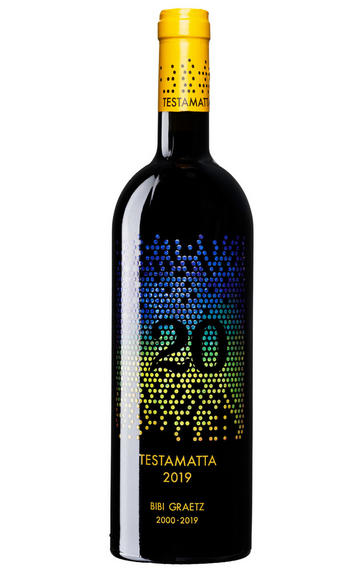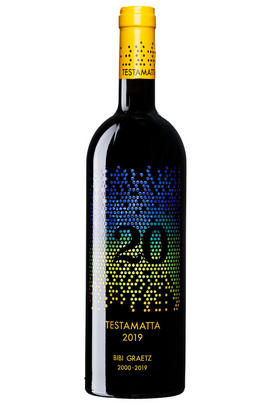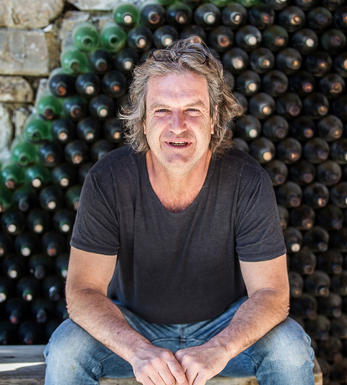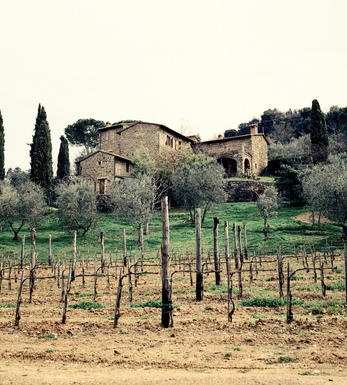
2019 Testamatta, Bibi Graetz, Tuscany, Italy

Critics reviews
Drink 2025 to 2040
Jane Anson, Inside Bordeaux (March 2022)
Drink 2022 - 2042
Monica Larner, Wine Advocate (Aug 2021)
James Suckling, jamessuckling.com (Aug 2021)
About this WINE

Bibi Graetz
Bibi Graetz founded his eponymous Tuscan winery in 2000. Born in Florence, Bibi comes from a family of artists. Bibi himself studied art before pursuing wine as a full-time endeavour. He still paints sometimes, notably for the striking labels of his wines including Colore and Testamatta. The operation is based out of a disused hotel, the Aurora, in the town of Fiesole which lies in the hills above Florence.
Working with his own estate vineyards as well as fruit sourced from other growers, Bibi describes his model as “Californian”. His white wines Colore Bianco and Testamatta Bianco come from fruit grown on the island of Giglio, around eight miles from the Tuscan coast. Both wines are produced from the Ansonica grape; the island is home to a stock of old vines, some up to 100 years old.
For his reds, he works with 100% Sangiovese fruit from a selection of vineyards in the hilly area best known for Chianti – though Bibi uses the Toscana IGT designation for his wines. Colore is now produced exclusively from old vines, at least 80 years old for the 2021 vintage. Bibi now makes Testamatta only from north-facing slopes.

IGT Tuscany
IGT (Indicazione Geografica Tipica) Tuscany is a wine classification from Italy's Tuscany region. It is one of the official wine classifications recognized by the Italian government. IGT is a step below the highest classification, DOCG (Denominazione di Origine Controllata e Garantita), and above the DOC (Denominazione di Origine Controllata) level.
The IGT classification was introduced in 1992 to allow winemakers more flexibility in grape varieties and employ winemaking techniques while still ensuring a certain level of quality and geographical indication. This classification gives winemakers more freedom to experiment and innovate, deviating from the strict regulations of the DOC and DOCG classifications.
IGT Tuscany wines can be produced throughout the entire region of Tuscany, encompassing various sub-regions and terroirs within the area. This classification allows winemakers to use traditional Tuscan grape varieties, such as Sangiovese, and non-traditional grape varieties, including international ones like Cabernet Sauvignon, Merlot, Syrah, and others.
The IGT Tuscany classification gives winemakers the flexibility to create wines that showcase the unique characteristics of their specific vineyards and winemaking styles. It allows for experimentation with blending different grape varieties, using innovative winemaking techniques, and exploring new regional vineyard sites.
IGT Tuscany wines can vary greatly, from traditional and terroir-driven expressions to more modern and international styles. This classification has played a significant role in developing Super Tuscan wines, often IGT designated and known for their high quality and international recognition.
Overall, IGT Tuscany provides a platform for winemakers in the region to express their creativity and produce wines that reflect their unique vision while maintaining a connection to the rich heritage and traditions of winemaking in Tuscany.

Sangiovese
A black grape widely grown in Central Italy and the main component of Chianti and Vino Nobile di Montepulciano as well as being the sole permitted grape for the famed Brunello di Montalcino.
It is a high yielding, late ripening grape that performs best on well-drained calcareous soils on south-facing hillsides. For years it was blighted by poor clonal selection and massive overcropping - however since the 1980s the quality of Sangiovese-based wines has rocketed upwards and they are now some of the most sought after in the world.
It produces wines with pronounced tannins and acidity, though not always with great depth of colour, and its character can vary from farmyard/leather nuances through to essence of red cherries and plums. In the 1960s the advent of Super Tuscans saw bottlings of 100% Sangiovese wines, as well as the introduction of Sangiovese/Cabernet Sauvignon blends, the most famous being Tignanello.


Buying options
Add to wishlist
Description
A pure expression of Sangiovese, the Bibi Graetz 2019 Testamatta is a wine in constant evolution. Bibi has added 17 more hectares of vineyard to the program, with 12 hectares in Fiesole (north of Florence) and 5 hectares in San Donato in Colle (south of Florence) with 70-year-old vines. The base of the wine sees fruit from old vines planted in the 1950s in the cool-climate Lamole subzone of Chianti Classico. These new terroirs bring a lot more aromatic nuance and complexity to the wine with perfumed blue flower, candied orange peel, wet earth and plumy black fruit. White Alberese soils add a strong chalky mineral signature to the finish of this elegantly streamlined and linear Tuscan red.
Drink 2022 - 2042
Monica Larner, Wine Advocate (Aug 2021)
This wine will be delivered by Spring 2022
wine at a glance
Delivery and quality guarantee